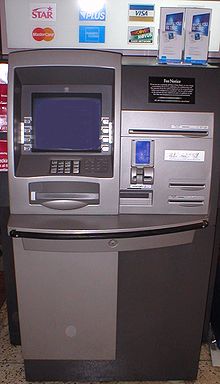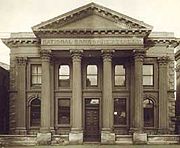- Transactional account
-
Types of banksCentral bank
Advising bank · Commercial bank
Community development bank
Cooperative bank · Credit union
Custodian bank · Depository bank
Export credit agency
Investment bank · Industrial bank
Merchant bank · Mutual savings bank
National bank · Offshore bank
Postal savings system
Private bank · Retail Bank
Savings and loan association
Savings bank · Universal bank
more...Bank cardsBanking termsLoan · Money creation
Automatic teller machine
Bank regulation · Anonymous banking
Islamic banking · Private banking
Ethical bankingA transactional account is a deposit account held at a bank or other financial institution, for the purpose of securely and quickly providing frequent access to funds on demand, through a variety of different channels.
Transactional accounts are meant neither for the purpose of earning interest nor for the purpose of savings, but for convenience of the business or personal client; hence they tend not to bear interest. Instead, a customer can deposit or withdraw any amount of money any number of times, subject to availability of funds.
Contents
Name
A transactional account is known as a checking account (or chequing account) in North America,[1] and as a current account or cheque account in the United Kingdom, Hong Kong and some other countries. Because money is available on demand it is also sometimes known as a demand account or demand deposit account.
History
In Holland in the early 1500s Amsterdam was a major trading and shipping city. In order to protect their large accumulations of cash, people began to depositing their money with "cashiers". These cashiers held the money for a fee. Competition drove cashiers to offer additional services including paying out money to any person bearing a written order from a depositor to do so. They kept the note as proof of payment.
This idea spread to other countries including England, and the English colonies in North America, where land owners in Boston in 1681 mortgaged their land to cashiers which would provide an account against which they could write checks.
In the eighteenth century in England preprinted checks, serial numbers, and the very word "cheque" appeared. By the late eighteenth century, the difficulty of clearing checks (sending them from one bank to another for collection) gave rise to the development of clearing houses.
Features and access
All transactional accounts offer itemized lists of all financial transactions, either through a bank statement or a passbook. A transactional account allows the account holder to make or receive payments by:
- ATM cards (withdraw cash at any Automated Teller Machine)
- debit card (cashless direct payment at a store or merchant)
- cash money (coins and banknotes)
- cheque and money order (paper instruction to pay)
- direct debit (pre-authorized debit)
- Electronic funds transfers (transfer funds electronically to another account)
- giro (funds transfer, direct deposit)
- standing order (automatic funds transfer)
- SWIFT: International account to account transfer.
- Online banking (transfer funds directly to another person via internet banking facility)
Country specific
 The cheque is the traditional mode of payment for a transactional account.
The cheque is the traditional mode of payment for a transactional account.
Certain modes of payment are country-specific:
- In the United Kingdom, BACS offers giros that clear in a matter of days while CHAPS is done on the same day.
- Canada has an Email Money Transfer service
- The United States offers e-checks.
- In India, NEFT and RTGS services are available to
Access
 An Automated Teller Machine (ATM)
An Automated Teller Machine (ATM)
Branch networks
Main article: Branch bankingThis refers to the practice of maintaining physical locations where customers can receive a wide array of banking and financial services, such locations are described as branches. They may provide access to a combination of cash machines, telephone banking, counter services and financial advice.
Cash machines
Main article: Automated teller machineOverdrafts
Main article: OverdraftIn North America, overdraft protection is an optional feature of a chequing account. An account holder may either apply for a permanent one, or the financial institution may, at its sole discretion, provide a temporary overdraft on an ad-hoc basis.
Interest
Main article: InterestFormerly, in the United States, Regulation Q (12 CFR 217) and the Banking Acts of 1933 and 1935 (12 USC 371a) prohibited a member of the Federal Reserve system from paying interest on chequing accounts. Historically, this restriction was frequently circumvented by either creating an account type such as a Negotiable Order of Withdrawal account (NOW account) which is legally not a chequing account or by offering interest paying chequing through a bank which is not a member of the Federal Reserve system. The Dodd-Frank Wall Street Reform and Consumer Protection Act, however, passed by Congress and signed into law by President Obama on July 21, 2010, repealed the statutes that prohibit interest-bearing transactional accounts, effectively repealing Regulation Q (Pub. L. 111-203, Section 627). The repeal took effect on July 21, 2011. Since that date, financial institutions have been permitted, but not required, to offer interest-bearing transactional accounts.
High-yield checking accounts
High-interest NOW accounts have become prevalent throughout the industry. They pay a higher interest rate than typical NOW accounts and frequently function as loss-leaders to drive relationship banking.
In 2003, banks and credit unions began to establish maximum balance accounts, which pay a premium rate up to a specified cap and a lower rate on balances above the cap. This counter-traditional trend (banks had typically established minimum account balances rather than maximum account balances) developed as a way to allow financial institutions to attract multiple customer relationships while limiting the interest expense associated with each account.
The first maximum balance, high-interest chequing account was offered in 2003 by a small community bank in New Mexico, Pioneer Bank. In 2004 and 2005, several community banks in West Texas adopted the idea, and a 3rd party vendor, BancVue, combined the maximum-balance concept with the idea of a higher yield for customers who adopt specific cost-savings behaviors, as a "Reward" Checking account.
Other imitators rapidly followed. By 2010, over 1.5 million REWARDChecking(r) accounts had been opened at BancVue's clients alone.[2]
The repeal of Regulation Q, which previously prohibited the payment of interest on standard transactional accounts, took effect too recently for it to have shown a major impact on banking practices. It is likely, however, that as time progresses the popularity of these alternative "checking" accounts will decline as clients opt for the less restrictive rules governing standard transactional accounts.
Internet banking
Main article: Online bankingInternet or Online banking describes the use of a bank's secure website to view balances and statements, perform transactions and payments, and various other facilities. This can be very useful, especially for banking outside bank hours and banking from anywhere where internet access is available. Since the internet revolution most retail banking institutions offer access to current accounts via online banking.
Telephone banking
Main article: Telephone bankingTelephone banking is the term applied to specific provision of banking services over the telephone. In many cases such calls are to a call centre or automated service, although some institutions continue to answer such calls in their branches. Often call centre opening times are considerably longer than branches, and some firms provide these services on a 24 hour basis.
Mail banking
Main article: Mail bankingStores and merchants providing debit card access
Main article: Debit cardOverdrafts
Main article: OverdraftAn overdraft occurs when withdrawals from a bank account exceed the available balance. This gives the account a negative balance and in effect means the account provider is providing credit. If there is a prior agreement with the account provider for an overdraft facility, and the amount overdrawn is within this authorised overdraft, then interest is normally charged at the agreed rate. If the balance exceeds the agreed facility then fees may be charged and a higher interest rate might apply.
Cost
The policy of charging a fee for doing financial transactions depends on a variety of factors, including the country and its overall interest rates for lending and for saving, as well as the size of the financial institution and the number of channels of access it offers. This is why operating few or no branches can afford to offer low-cost or free banking, and why, in some countries, transaction fees do not exist, but extremely high lending rates are the normal.
Financial transaction fees may be charged either per item or for a flat rate covering a certain number of transactions. Often, youths, students, senior citizens or high-valued customers do not pay fees for basic financial transactions. Some will offer free transactions for maintaining a very high average balance in their account. Other service charges are applicable for overdraft, non-sufficient funds, the use of an external interbank network, etc. In countries where there are no service charges for transaction fees, there are, on the other hand, other recurring service charges such as a debit card annual fee.
Interest
Main article: InterestUnlike savings accounts, for which the primary reason for depositing money is to generate interest, the main function of a transactional account is transactional. Therefore, most providers either pay no interest or pay a low level of interest on credit balances.
Current accounts
A current account is the form of transactional account found in the United Kingdom and other countries with a UK banking heritage; a current account offers various flexible payment methods to allow customers to distribute money directly to others. Most current accounts come with a cheque book and offer the facility to arrange standing orders, direct debits and payment via a debit card. Current accounts may also allow borrowing via an overdraft facility.
Lending
Current accounts have two different ways in which money can be lent: overdraft and offset mortgage.
Overdraft
Main article: OverdraftIn the UK, virtually all current accounts offer a pre-agreed overdraft facility the size of which is based upon affordability and credit history. This overdraft facility can be used at any time without consulting the bank and can be maintained indefinitely (subject to ad-hoc reviews). Although an overdraft facility may be authorised, technically the money is repayable on demand by the bank. In reality this is a rare occurrence as the overdrafts are profitable for the bank and expensive for the customer.
Offset mortgage
Main article: Offset mortgageAn offset mortgage was a type of mortgage common in the United Kingdom used for the purchase of domestic property, the key principle is the reduction of interest charged by "offsetting" a credit balance against the mortgage debt. This can be achieved via one of two methods either lenders provide a single account for all transactions (often referred to as a current account mortgage) or they make multiple accounts available which allow the borrowers to notionally split their money according to purpose whilst all accounts are offset each day against the mortgage debt.
Interest
Main article: InterestIn the UK some online banks offer rates as high as many savings accounts along with free banking (no charges for transactions) as institutions which offer centralised services (telephone, internet or postal based) tend to pay higher levels of interest. The same holds true for banks within the EURO currency zone.
See also
Transaction related
- Collection item
- Error account a necessity for auditing transaction accounts
- Demand draft
- Transaction deposit
Account type related
Notes
- ^ U.S. and Canadian spelling, respectively; see further at Etymology and spelling.
- ^ Media.sugarcrm.com
Categories:- Banking
- Banking terms and equipment
Wikimedia Foundation. 2010.

